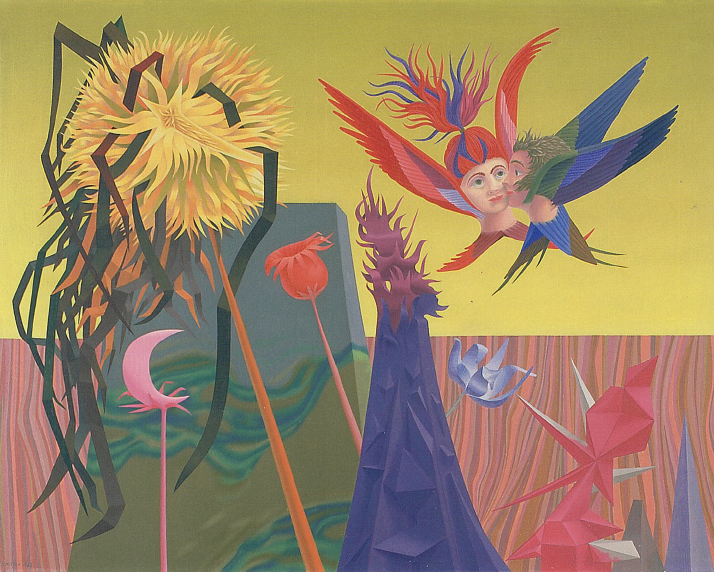Wolfgang Hutter

Wolfgang Hutter, Fliegende Köpfe, 1960
Oil on canvas
37 x 47 cm, frame: 50 x 60.5 cm
Courtesy Peter Infeld Private Foundation, Vienna
Wolfgang Hutter is a key member of the Vienna school of Fantastic Realism. He studied from 1945 to 1950 at the Academy of Fine Arts Vienna in the class of his father, Albert Paris Gütersloh. At the time, however, this family connection was not public knowledge. Hutter is the son of Milena Hutter, who had an affair of many years with Albert Paris Gütersloh. Gütersloh only recognized Wolfgang Hutter as his son in his will in 1973. This personal connection must certainly have played a role in the relationship between the two men, but ultimately the younger painter’s works stood the test of quality in their own right.
Hutter’s style and repertoire are perhaps the most independent and colorful of all the Fantastic Realists. His landscapes, mostly strange exterior spaces that look like fantastic stage sets, are peopled by exotic plants and mythical and strange creatures, set in complex scenes and often making “sweet” and very dream-like images. Hutter’s father Gütersloh described these landscapes in a text about his son’s work as follows: “But not according to the model of those purely figurative artists, who attempt to arrange flowers and other objects into a simple story, and to order the disorder of the still-life table in accordance with reproductions of optical perspectives; rather they float without roots in the blue skies […] here the two directions are the figurative and the abstract, connected with each other for at least this moment by a peace the painter creates.”1
We see this in the work Fliegende Köpfe (Flying Heads) (1960), with the heads of the title each with a pair of wings, looking like a hybrid creature of human and humming bird. These flying creatures pass by several plants that could be flowers in the broadest sense. They all have very accurately drawn stalks and are very straight. The reddish ground is painted with a stripe pattern, and all the other bodies (except the flying heads) have linear, geometrical non-organic forms. There are clear references to altar pieces like those by Hieronymus Bosch in Hutter’s work, and in addition to his cheerful pictures of paradise he also painted counterparts that recall depictions of Purgatory.
Hutter always rejected simplistic interpretations of his work and resisted any categorization in terms of art history and other contents outside the works themselves. In this sense, it is interesting to see the Fantastic Realists, or at least Hutter, as a kind of movement against modernist painting, and against a certain role of the artist in society and in respect of the audience: “There must also be a politeness the artist expresses toward his audience. For we both expect much of each other. It cannot be our wish to shout and scream at each other, when both sides wish for peace and for embraces. Concepts like beauty, elegance, mastery, relationships, and good technique, delicate surfaces, harmony, and others have unfortunately been taken out of service and sometimes turned into expletives. After these thoughts on the great divide between the audience and so-called ‘modern art’ it is appropriate to consider the ‘freedom’ of the artistic person.”2
Ultimately these thoughts are designed not only to give the artist the greatest possible freedom to operate, something that Hutter saw as given, but also to empower viewers in the best possible way. A direct relationship between beholder and artwork is the center of focus, and it is seen to be a social ideal.
- Albert Paris Gütersloh, “Vom Eros des Malers,“ in Die Phantasten, ed. Gesellschaft bildender Künstler Österreichs, Künstlerhaus Wien, Vienna 1990, p. 245.
- Wolfgang Hutter, “Eine traurige Geschichte – Gibt es noch die sogenannte Kunst?,“ in Die Phantasten, ed. Gesellschaft bildender Künstler Österreichs, Künstlerhaus Wien, Vienna 1990, pp. 248 f.